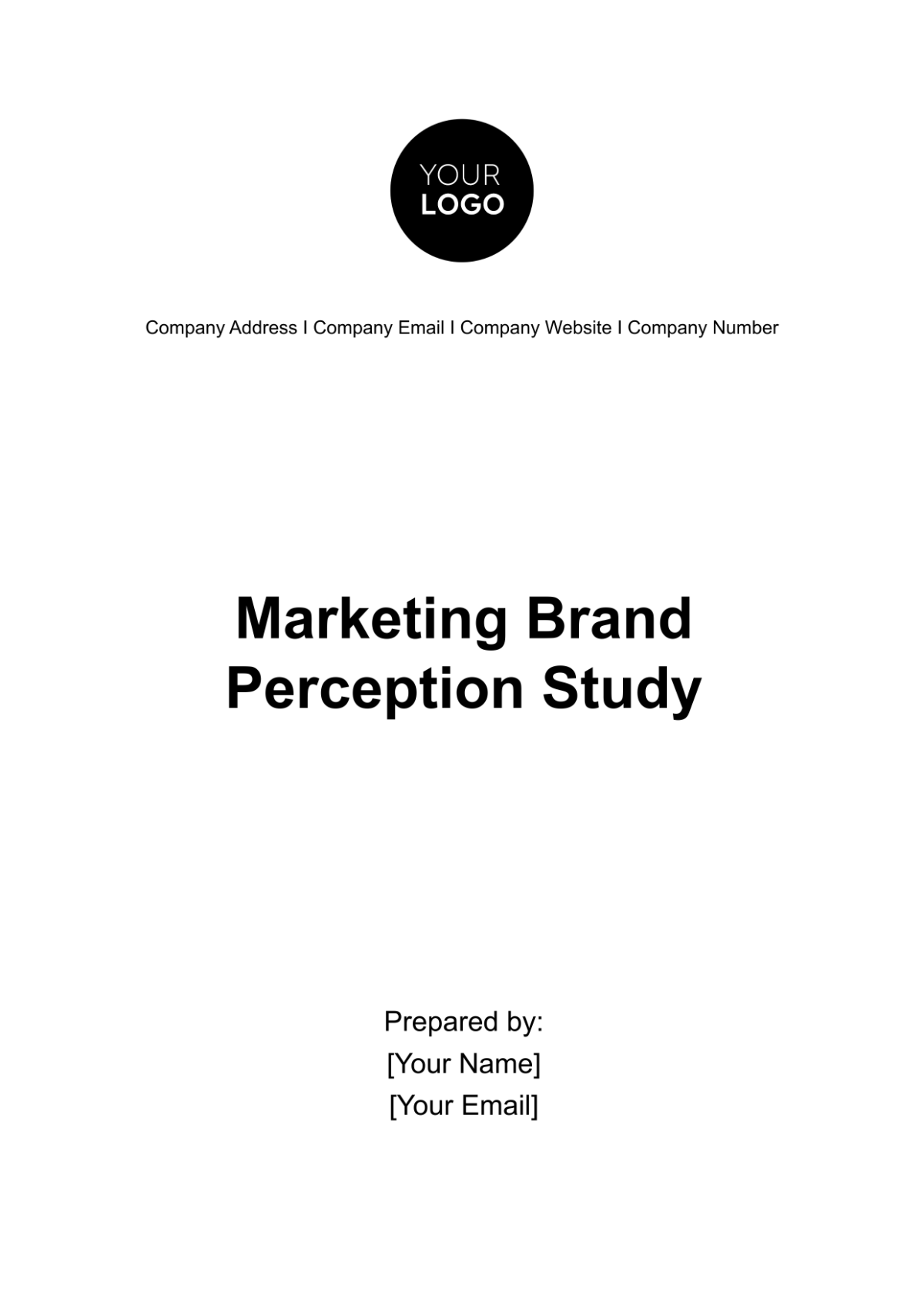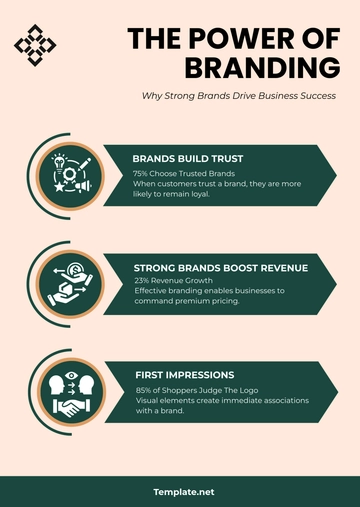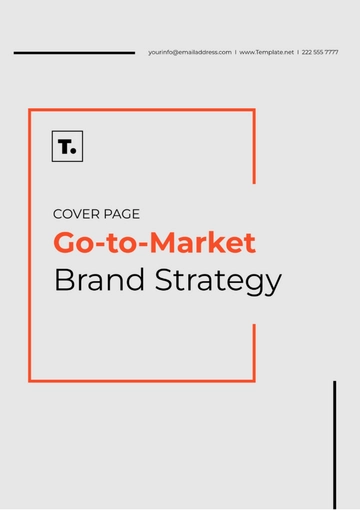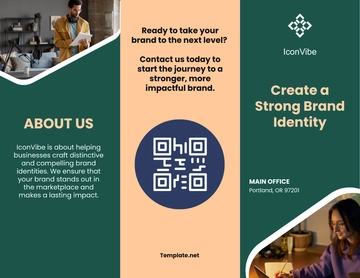Free Marketing Brand Perception Study

Abstract
In an era marked by unprecedented technological leaps and shifting consumer dynamics post-2050, understanding brand perception is more vital than ever for businesses. This study dives deep into the brand perception of [Your Company Name], examining its position in the marketplace through various investigative lenses.
Leveraging online surveys, face-to-face interviews, and cutting-edge social media sentiment analysis, we offer a comprehensive view of customer sentiments, awareness, and loyalty. The results shed light on the company's brand strengths and areas of potential growth, providing actionable insights for stakeholders and decision-makers.
Introduction
Brand perception is no longer a static concept relegated to logos and slogans; it's a multifaceted construct shaped by diverse touchpoints across a customer's journey. In this milieu, understanding how [Your Company Name] is perceived provides invaluable insights into potential market opportunities and areas of enhancement.
Purpose
Brand perception is pivotal in driving consumer decisions and brand loyalty. This research unravels how the company is perceived in the ever-evolving business arena post-2050. Through this study, we aim to elucidate the brand's strengths, potential challenges, and chart a course for future strategic endeavors.
Methodology
To ensure a comprehensive understanding of [Your Company Name]'s brand perception, a mixed-methods research approach was employed. This strategy combined both quantitative and qualitative techniques, offering a richer and more nuanced insight into the topic.
Data Collection Tools:
1. Online Surveys: A structured questionnaire was disseminated to a diverse group of 5,000 respondents spanning different demographics, geographies, and purchasing histories with the company. The survey was designed to capture metrics on brand recognition, association, and loyalty.
2. Face-to-Face Interviews: Semi-structured interviews were conducted with 200 participants. These interviews provided deeper insights into the consumer's feelings, attitudes, and experiences with the company.
3. Social Media Sentiment Analysis: An AI-driven tool was used to scrape and analyze 10,000 mentions of [Your Company Name] across major social media platforms over the past six months. This ensured real-time and up-to-date feedback from the digital populace.
Sampling:
A stratified random sampling method was employed to ensure representation from different customer segments of the company. This allowed for more generalizable and unbiased results.
Data Analysis:
Quantitative data from the online surveys and sentiment analysis was processed using statistical software to determine patterns, correlations, and significant findings. Qualitative data from the interviews were transcribed, coded, and thematically analyzed to derive key insights and narratives around the company's brand perception.
Limitations:
While the mixed-methods approach offers comprehensive insights, potential biases in self-reported data and the limited timeframe of social media analysis need to be acknowledged. Additionally, external factors like market trends and global events that might have influenced the brand perception during the research period were not extensively explored in this study.
Results
Brand Recognition: A crucial aspect of brand health, brand recognition reflects how promptly consumers identify a brand, either through its logo, slogan, or other brand elements.
Statement 1: I instantly recognize the logo of [Your Company Name].
Statement 2: [Your Company Name]'s recent advertisements are memorable to me.
Social Media Sentiment: In the digital age, social media sentiment serves as a pulse check on real-time brand health. Below is the Social Media Sentiment Analysis (from a sample of 10,000 mentions):
Key Insights from Qualitative Analysis:
80% of participants had favorable experiences with the company's products/services, mentioning high quality and reliability.
65% of participants stated they had recommended the company to their friends or colleagues.
A minority, 15%, expressed a desire for better post-purchase customer support.
Key Insights from Comparative Analysis:
60% felt [Your Company Name] offered better quality.
20% perceived it to be on par with industry standards.
20% were either unfamiliar with competitors or felt other brands had a slight edge in certain areas.
Discussion
The data amassed paints a multifaceted picture of [Your Company Name]'s brand perception in the post-2050 business environment. While the numbers and percentages provide quantifiable insights, understanding their implications and synthesizing them into a coherent narrative is critical for strategic direction. In this section, we delve deeper into the data, unraveling the story behind the numbers and offering a nuanced understanding of what they signify for the brand.
Brand Recognition and Awareness:
The results elucidate a positive trend for [Your Company Name] in the realm of brand recognition. A significant 88% of respondents either strongly agree or agree that they can instantly recognize the company's logo, suggesting a solid brand footprint in the consumer's psyche. However, the memorability of recent advertisements, standing at 70%, indicates a potential area for creative reinvention. Ensuring that advertisements not only reach the audience but also resonate with them is paramount for sustained brand engagement.
Digital Sentiment as a Brand Barometer:
The overwhelming 70% positive sentiment on social media is a testament to the company's effective digital engagement strategies. While this is laudable, the 10% negative sentiment shouldn't be overlooked. In the age of virality, even a minor oversight can escalate into a significant brand crisis. Deep diving into the reasons for negative sentiments can provide actionable insights for remediation.
The Trust Quotient:
Trust remains a pivotal currency in the brand world. With 85% of interviewees expressing trust in the products and services of the company, the brand has a strong foundation. However, maintaining this trust requires continuous effort, especially in a fast-evolving market landscape.
Qualitative Insights – The Beneath-the-surface Story:
The qualitative data underscores the brand's strengths while also shining a light on areas needing attention. Positive experiences and a high rate of brand advocacy indicate strong customer satisfaction. However, the feedback on post-purchase customer support is a clear call to action.
Positioning Amidst Competitors:
The comparative analysis suggests that [Your Company Name] enjoys a competitive edge in terms of product and service quality. However, staying complacent is not an option. With 20% of respondents perceiving competitors on par or superior in some areas, continuous innovation and staying attuned to market needs is essential.
Synthesizing the Data:
When assimilating the quantitative and qualitative insights, it's clear that the company has a robust brand equity. But, like any brand in a dynamic market, there are areas of improvement. Addressing these, while leveraging the brand's strengths, will ensure that the company not only remains a market leader but also sets industry benchmarks.
When assimilating the quantitative and qualitative insights, it's clear that [Your Company Name] has a robust brand equity. But, like any brand in a dynamic market, there are areas of improvement. Addressing these, while leveraging the brand's strengths, will ensure that the company not only remains a market leader but also sets industry benchmarks.
Recommendations
In the ever-evolving business landscape, understanding brand perception and its nuances are only half the battle; the other half lies in actioning insights to foster continued growth and resonance with the audience. Based on the data derived from our research, and to address the challenges while optimizing strengths, the following strategic recommendations are proposed for [Your Company Name]:
1. Elevate Advertising Creativity: Considering that a sizable proportion of respondents couldn't recall recent advertisements, there's a need to reimagine advertising content. Emphasize storytelling, use of emerging technologies like augmented reality, or engage in impactful influencer partnerships to enhance advertisement recall and resonance.
2. Strengthen Digital Engagement: While the positive sentiment on social media is commendable, proactive strategies can further bolster this. Engage with audiences through interactive content, live sessions, AMAs (Ask Me Anything), or user-generated content campaigns. Addressing the 10% negative sentiment promptly and transparently can convert detractors into brand advocates.
3. Enhance Customer Support Initiatives: The feedback regarding post-purchase support is a clear signal. Invest in training for customer support teams, introduce AI-driven chatbots for 24/7 assistance, and consider loyalty programs that offer exclusive benefits to recurring customers.
4. Continuous Product and Service Innovation: Given that some respondents perceive competitors on par or slightly better in some areas, R&D investment is vital. Regularly solicit feedback, conduct beta testing for new offerings, and always be in the loop about industry advancements.
5. Community Building and Trust Enhancement: Organize community events, webinars, or workshops not just to promote products but to genuinely engage with and educate the audience. Transparent communication about company practices, CSR initiatives, and taking a stance on global issues can significantly enhance trust.
6. Competitive Analysis: Undertake periodic competitive analysis to understand the strengths and weaknesses of competitors. This can offer insights into potential market opportunities and inform strategic decisions.
7. Embrace Sustainable and Ethical Practices: As consumers become increasingly conscious of sustainability and ethics, ensure that the company's operations, products, and services align with these values. Transparently communicate any green initiatives or ethical practices to the audience.
8. Feedback Loop Creation: Establish a system where customer feedback is continuously collected, analyzed, and acted upon. This not only aids in immediate redressal but also in long-term strategic planning.
By integrating these recommendations, [Your Company Name] can fortify its brand presence, enhance customer loyalty, and ensure continued market leadership in the foreseeable future.
Conclusion
In today's rapidly transforming marketplace, [Your Company Name] stands as a testament to adaptability, innovation, and customer-centricity. The strides it has taken in establishing its brand identity and resonance are laudable.
However, like any dynamic entity, there are avenues waiting to be explored and potential waiting to be tapped. By synergizing its inherent strengths and addressing its challenges, the company is poised not just to maintain its market standing but to redefine industry benchmarks.
Acknowledgment
Our profound appreciation goes out to every individual who contributed to this research. The invaluable inputs from survey and interview participants have been the cornerstone of this study. Additionally, a special note of thanks to the dedicated social media analysis team, whose meticulous efforts have provided a holistic view of [Your Company Name]'s digital brand sentiment.
Marketing Templates @ Template.net
- 100% Customizable, free editor
- Access 1 Million+ Templates, photo’s & graphics
- Download or share as a template
- Click and replace photos, graphics, text, backgrounds
- Resize, crop, AI write & more
- Access advanced editor
Introducing the Marketing Brand Perception Study Template on Template.net! This editable and customizable tool enables precise analysis of brand perception. Tailor it to your specific requirements using our Ai Editor Tool. Seamlessly gather insights to refine your brand strategy. Elevate your market understanding effortlessly with this essential template. Start optimizing today!





























